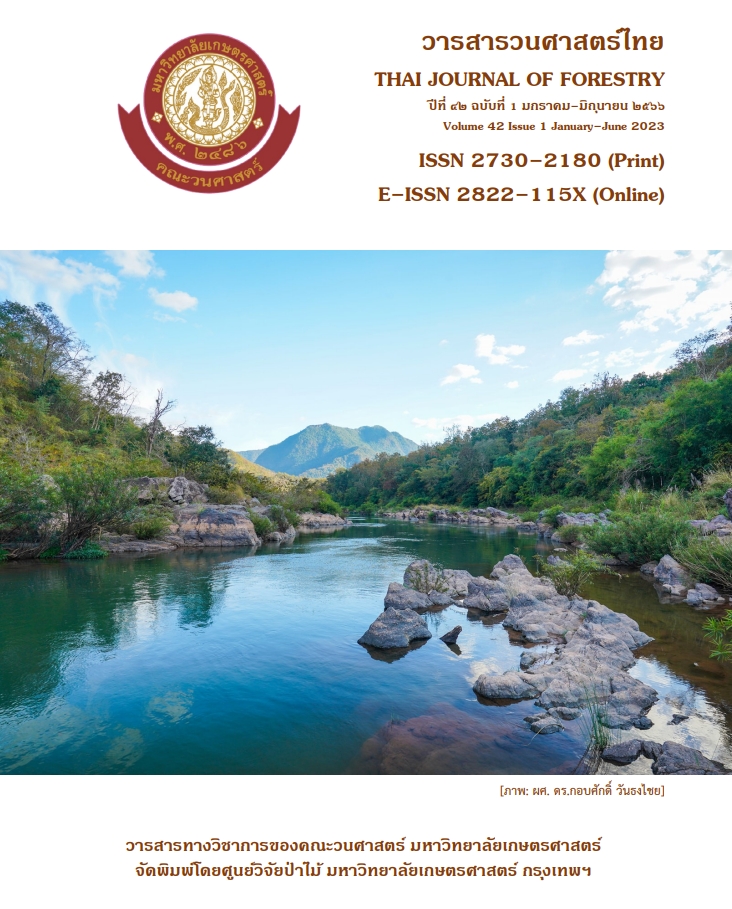การประเมินถิ่นที่อาศัยที่เหมาะสมของกวางผา (Naemorhedus griseus) ในพื้นที่เขตรักษาพันธุ์สัตว์ป่าเชียงดาว จังหวัดเชียงใหม่ ด้วยแบบจำลองแมกซ์เซน
Main Article Content
บทคัดย่อ
การศึกษาครั้งนี้มีวัตถุประสงค์เพื่อประเมินถิ่นที่อาศัยที่เหมาะสมของกวางผา (Naemorhedus griseus) ในพื้นที่เขตรักษาพันธุ์สัตว์ป่าเชียงดาว โดยใช้ปัจจัยสิ่งแวดล้อมประกอบด้วยปัจจัยด้านชีวภูมิอากาศและปัจจัยสิ่งแวดล้อมทางกายภาพ ที่มีผลต่อการเลือกถิ่นที่อาศัยของกวางผา โดยนำค่าพิกัดทางภูมิศาสตร์ที่สำรวจพบร่องรอยของกวางผาขณะเดินลาดตระเวนเชิงคุณภาพ (SMART Patrol) ในพื้นที่ จำนวน 244 พิกัด มาวิเคราะห์ข้อมูลด้วยแบบจำลองแมกซ์เซน
จากการศึกษาครั้งนี้ พบว่าความสามารถในการทำนายมีค่าที่ดีมาก คือ ค่าพื้นที่ใต้กราฟ (area under the curve: AUC) เท่ากับ 0.857 โดยปัจจัยแวดล้อมที่มีความสำคัญในการกำหนดการเลือกถิ่นที่อาศัยของกวางผาในพื้นที่เขตรักษาพันธุ์สัตว์ป่าเชียงดาว คือ ความสูงจากระดับน้ำทะเล ปริมาณน้ำฝน อุณหภูมิ และความลาดชันของพื้นที่ ตามลำดับ พื้นที่ที่เหมาะสมสำหรับเป็นที่อยู่อาศัยของกวางผา แบ่งออกได้ 4 ระดับ โดยเรียงลำดับจากมากไปหาน้อย ดังนี้ มีความเหมาะสมน้อยที่สุด มีความเหมาะสมต่ำ มีความเหมาะสมสูง และมีความเหมาะสมปานกลาง คิดเป็นร้อยละ 67.23 , 20.07 , 7.32 และ 5.39 ของพื้นที่ทั้งหมด เมื่อแบ่งพื้นที่ตามขอบเขตการปกครอง ตำบลที่มีความเหมาะสมสำหรับเป็นที่อยู่อาศัยของกวางผา ได้แก่ ตำบลเชียงดาว ตำบลแม่นะ ตำบลเมืองงาย และตำบลเมืองคอง พื้นที่ดังกล่าวจึงต้องอนุรักษ์ ปกป้อง คุ้มครอง โดยให้มีกิจกรรมของมนุษย์น้อยที่สุด เพื่อลดผลกระทบต่อการดำรงชีพของกวางผาในพื้นที่ และยังสามารถใช้เป็นแหล่งพันธุกรรมในธรรมชาติที่สำคัญแห่งหนึ่งของประเทศไทยที่จะเพาะพันธุ์และกระจายพันธุ์ออกไปในพื้นที่ป่าอนุรักษ์แห่งอื่นที่มีความเหมาะสมที่อยู่ใกล้เคียง ต่อไป
Downloads
Article Details

อนุญาตภายใต้เงื่อนไข Creative Commons Attribution-NonCommercial-NoDerivatives 4.0 International License.
ข้าพเจ้าและผู้เขียนร่วม (ถ้ามี) ขอรับรองว่า ต้นฉบับที่เสนอมานี้ยังไม่เคยได้รับการตีพิมพ์และไม่ได้อยู่ในระหว่างกระบวนการพิจารณาตีพิมพ์ลงในวารสารหรือสิ่งตีพิมพ์อื่นใด ข้าพเจ้าและผู้เขียนร่วม (ถ้ามี) ยอมรับหลักเกณฑ์และเงื่อนไขการพิจารณาต้นฉบับ ทั้งยินยอมให้กองบรรณาธิการมีสิทธิ์พิจารณาและตรวจแก้ต้นฉบับได้ตามที่เห็นสมควร พร้อมนี้ขอมอบลิขสิทธิ์ผลงานที่ได้รับการตีพิมพ์ให้แก่วารสารวนศาสตร์ คณะวนศาสตร์ มหาวิทยาลัยเกษตรศาสตร์ กรณีมีการฟ้องร้องเรื่องการละเมิดลิขสิทธิ์เกี่ยวกับภาพ กราฟ ข้อความส่วนใดส่วนหนึ่ง หรือ ข้อคิดเห็นที่ปรากฏในผลงาน ให้เป็นความรับผิดชอบของข้าพเจ้าและผู้เขียนร่วม (ถ้ามี) แต่เพียงฝ่ายเดียว และหากข้าพเจ้าและผู้เขียนร่วม (ถ้ามี) ประสงค์ถอนบทความในระหว่างกระบวนการพิจารณาของทางวารสาร ข้าพเจ้าและผู้เขียนร่วม (ถ้ามี) ยินดีรับผิดชอบค่าใช้จ่ายทั้งหมดที่เกิดขึ้นในกระบวนการพิจารณาบทความนั้น”
เอกสารอ้างอิง
Anderson, R.P., Lew, D., Peterson, A.T. 2003. Evaluating predictive models of species distributions: criteria for selecting optimal models. Ecological Modelling, 162(3): 211–232.
Berhanu, Y., Tassie, N., Sintayehu, W.D. 2022. Predicting the Current and Future suitable Habitats for Endemic and Endangered Ethiopian Wolf Using MaxEnt Model. Africa Center of Excellence for Climate Smart Agriculture and Biodiversity Conservation, Haramaya University, Ethiopia.
Deeprasai, V. 2006. Application of Geographic Information System and Remote Sensing for Goral’s Habitat Assessment in Omkoi Wildlife Sanctuary Changwat Chiang Mai. M.S. Thesis, Kasetsart University, Bangkok, Thailand. (in Thai)
Division of Land and Forest Resources. 1999. Master Plan for Area Management in Chiang Dao Wildlife Sanctuary, Chiang Mai Province. Land and Forest Resources Division, Natural Resources Conservation Office, Royal Forest Department, Bangkok, Thailand. (in Thai)
Dormann, F.C., McPherson, M.J., Araújo, B.M., Bivand, R., Bolliger, J., Carl, G., Davies, G.R., Hirzel, A., Jetz, W., Daniel Kissling, W., Kühn, I., Ohlemüller, R., Peres-Neto, R.P., Reineking, B., Schröder, B., Schurr, M.F., Wilson, R. 2007. Methods to account for spatial autocorrelation in the analysis of species distributional data: a review. Ecography, 30: 609-628. https://doi.org/10.1111/j.2007.0906-7590.05171.x
Fielding, A.H., Bell, J.F. 2007. A review of methods for assessment of prediction errors in conservation presence/absence models. Environment Conservation, 24: 38-49.
Hijmans, R.J., Cameron, S.E., Parra, J.L., Jones, P.G., Jarvis, A. 2005. A very high resolution interpolated climate surface for global land areas. International Journal of Climatology, 25: 1965-2198.
IPCC. 2007. Contribution of Working Groups I, II, III to the Fourth Assessment Report of the Intergovernmental Panel on Climate Change. Climate Change 2007. Synthesis Report, Geneva, Switzerland.
IUCN. 2008. The IUCN Red List of Threatened Species. https://www.iucnredlist.org/species/14303/430834/, 24 July 2020.
Kamyo, T., Asanok, L. 2020. Modeling habitat suitability of Dipterocarpus alatus (Dipterocarpaceae) using MaxEnt along the Chao Phraya River in Central Thailand. Forest Science and Technology, 16(1): 1-7. (in Thai)
Khanum, R., Mumtaz, A.S., Kumar, S. 2013. Predicting impacts of climate change on medicinal asclepiads of Pakistan using Maxent modeling. Acta Oecologica, 49: 23-31.
Lekagul, B. McNeely, J.A. 1977. Mammal of Thailand. Kuruspha Ladprao, Bangkok, Thailand. (in Thai)
Office of Natural Resources and Environmental Policy and Planning. 2005. Summary Thailand Red Data Vertebrates. Ministry of Natural Resources and Environment, Bangkok, Thailand. (in Thai)
Planisong, K., Trisurat, Y., Sookchaloem, D., Bhumpakphan, N. 2019. Co-habitats Model of Gaur and Elephant at Phu Khieo Wildlife Santuary, Chaiyaphum Provine. Department of Forest Biology, Faculty of Forestry, Kasetsart University, Bangkok, Thailand. (in Thai)
Phillips, S.J., Dudik, M. 2008, Modeling of species distributions with maxent: New extensions and a comprehensive evaluation. Ecography, 31(2): 161-175.
Phillips, S.J., Anderson R.R., Schapire, R. 2006. Maximum entropy modeling of species geographic distributions. Ecological Modelling, 190(3-4): 231-259.
Safoowong, M. 2018. Population Status and Distribution of Chinese Goral in Thailand. Department of National Parks, Wildlife and Plant Conservation, Bangkok, Thailand. (in Thai)
Scheldeman, X., Zonneveld, M. 2010. Training Manual on Spatial Analysis of Plant Diversity and Distribution. Biodiversity International, Rome, Italy.
Swets, J.A. 1988. Measuring the accuracy of diagnostic systems. Science, 240: 1285-1293. doi: 10.1126/science.3287615
United Nations Educational, Scientific and Cultural Organization (UNESCO). 2021. Biosphere reserves in Asia and the Pacific. https://en.unesco.org/biosphere/aspac/, 20 December 2020.
Wildlife Conservation Society – Thailand Program. 2015. SMART Patrol Technique for Protected Area Management. Saeng Muang Printing Company, Nonthaburi, Thailand. (in Thai)
Wildlife Conservation Office. 2020. Wild Animal Reservation and Protection Act, B.E., 2562 (2019). Department of National Parks, Wildlife and Plant Conservation, Bangkok, Thailand. (in Thai)
Xu, N., Meng, F., Zhou, G., Li, Y., Wang, B., Lu, H. 2020. Assessing the suitable cultivation areas for Scutellaria baicalensis in China using the Maxent model and multiple linear regression. Biochemical Systematics and Ecology, 90: 104052. https://doi.org/10.1016/j.bse.2020.104052.
Yackulic, C.B., Chandler, R., Zipkin, E.F., Royle, J.A., Nichols, J.D., Campbell Grant, E.H., Veran, S. 2013. Presence only modelling using MAXENT: when can we trust the inferences? Methods in Ecology and Evolution, 4: 236-243. https://doi.org/10.1111/2041-210x.12004


